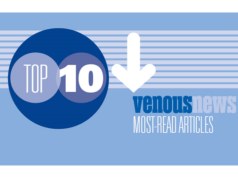By David L Gillespie
Varicose veins are a common condition affecting more than 25 million people in the United States. While the genetic basis of varicose veins remains to be elucidated, it is clear they can arise in young individuals with no predisposing risk factors. This suggests inborn genetic traits play a key role in the development of abnormal veins. Moreover, it is also likely that genetic variation, persistent ambulatory venous hypertension and chronic inflammation influence the development of chronic venous disease.
The incidence of varicose veins increases with age. Up to 80% of varicose veins result from primary valvular incompetence with the remaining resulting from the post-thrombotic syndrome. Primary varicose veins have an annual incidence of 2.6% in women and 1.9% in men with a prevalence of 25%–33% in Western female subjects.
Varicose veins have altered collagen content. Matrix metalloproteinases such as collagenases, gelatinases and stromelysins have been implicated in regulating this process. Recent studies by Rafetto et al have shown prolonged increases in vein wall tension from increase matrix metalloproteinase expression and decrease constriction in the venous wall.This is hypothesized to lead to overall venous dilation and subsequent varicose vein formation.
There have been several reports of familial clustering in patients with varicose veins. In 1969, research by Hauge and Gundersen concluded that the inheritance of varicose veins is likely to be multifactorial. Matousek and Prerovsky in 1974, estimated up to 50% of patients with varicose veins had some genetic linkage. In 1997, Serra et al found that varicose vein formation in a small subset of patients was genetically linked to a mutation in the FOXC2 gene. In this group of patients with lymphoedema-distichiasis syndrome; varicose veins were noted to have both early onset and increased prevalence compared with general population. Up to 49% of these patients had varicose veins with age of onset between 7 and 28 years. These data suggest a possible developmental role for FOXC2 in both venous and lymphatic systems. This is the first gene that has been implicated in the etiology of varicose veins.
Another biomarker associated with varicose vein development is the NOTCH3 gene. This gene is mutated in patients with cerebral autosomal-dominant arteriopathy with subcortical infarcts and leukoencephalopathy (CADASIL) syndrome. CADASIL results from mutations in the NOTCH3 gene, a receptor for several membrane-bound ligands that play a central role in development. Other reports have found associations between varicose veins and mutations in the thrombomodulin promoter gene, the NDP gene and the TGF-β receptor–2 gene.
In conclusion the pathogenesis of varicose veins remains poorly understood. In the past decade, there has been a shift from initial theories that were based on purely mechanical factors to now hypotheses focusing on complex molecular and histopathologic alterations in the vessel wall. There is clearly a genetic component to venous disease leading to histologic and molecular alterations. The degree of clinical severity is compounded by lifestyle and other demographic factors on top of this. Genetic screening and gene-targeted therapy could eventually play a role in the clinical management of varicose veins in the future. This would be an especially important breakthrough in our efforts to eradicate chronic venous ulceration and its sequelae.
David L Gillespie is professor of Surgery and chief Division of Vascular Surgery at the University of Rochester School of Medicine and Dentistry, Rochester, USA.









